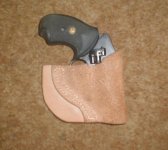Many, perhaps even most, guns can be carried safely. Start by using a holster, or having nothing else in your pocket. Assuming that you know and follow most of the safety rules, perhaps the most dangerous thing about everyday carry is holstering or pocketing the weapon. You need to be sure that nothing depresses the trigger. Obviously, guns that have a manual safety which is already engaged when holstering add a layer of safety, but not all guns, even autoloaders, have one, and it isn't the best thing to depend on one. On a gun which is carried cocked, like the 1911, I holster it only while holding the hammer back with my thumb. On DA revolvers or autos carried uncocked, I hold the hammer forward with my thumb while holstering. With the Glock or similar actions, I usually consider it best to leave the gun in the store that is offering it for sale. However, such a gun (and the current hammerless revolvers are similar) can usually be safely holstered by doing it with the finger in the trigger guard behind the trigger. If you can't do this, you need a different holster or maybe even a different gun.
In general, a revolver is much more easily and safely unloaded and reloaded, at least indoors. Outdoors, it doesn't make much difference - just follow normal safe range procedures. Indoors, however, it may not be so easy to find that safe direction to point the thing, since you should only be pointing at things that you don't mind killing, like your TV.
If you seldom load or unload indoors, it probably doesn't make much difference. But if you go through this daily, you might want to consider whether sometimes you will come home dead tired, and still think that you should be unloading that thing. That's when accidents happen, even with a revolver. Also, some folks wake up faster than others, and some are a bit dependent on caffeine.
Can you tell that I like revolvers? But I don't completely rule out bottomfeeders for those whose routine and personal characteristics they may fit.


